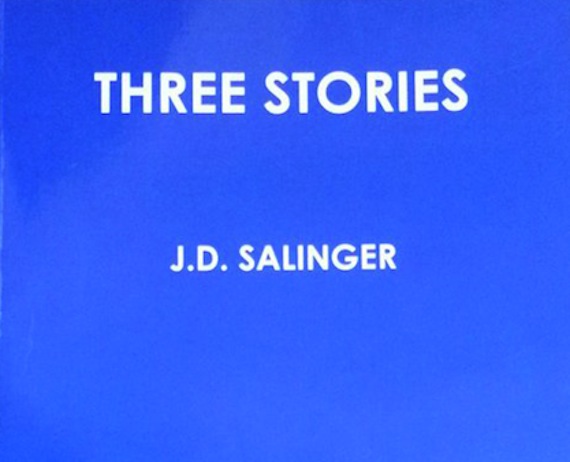
Literature fans have doubtless heard about the three unpublished J.D. Salinger stories leaked online last month. A scanned manuscript entitled Three Stories in a style reminiscent of the Bantam Salinger editions surfaced on a torrent site in November, and the stories, “The Ocean Full of Bowling Balls,” “Paula,” and “Birthday Boy,” were previously kept under wraps in the research sections of the Princeton and University of Texas libraries. The most viable theories say that the manuscript was photocopied in the years before the libraries cracked down on security, or that someone surreptitiously copied it in longhand when no one was looking.
 Though “Birthday Boy” and “Paula” are rougher, less succinct drafts with typos and cross-outs, “The Ocean Full of Bowling Balls” will hold the most interest for readers, as it contains a young Holden Caulfield from The Catcher in the Rye and shows the death of Holden’s younger brother, an incident only alluded to in the novel. The story is memorable, insightful, and funny, and easily ranks among Salinger’s best. So why did he insist it not be published until 50 years after his death?
Though “Birthday Boy” and “Paula” are rougher, less succinct drafts with typos and cross-outs, “The Ocean Full of Bowling Balls” will hold the most interest for readers, as it contains a young Holden Caulfield from The Catcher in the Rye and shows the death of Holden’s younger brother, an incident only alluded to in the novel. The story is memorable, insightful, and funny, and easily ranks among Salinger’s best. So why did he insist it not be published until 50 years after his death?
When Salinger was writing Catcher, he was also writing short stories about Holden Caulfield and his family. Some got published, and some didn’t. Like “The Ocean Full of Bowling Balls,” some of them are narrated by Holden’s older brother Vincent, an aspiring writer renamed D.B. in Catcher, where he’s off “being a prostitute” of a screenwriter.
 Vincent Caulfield’s status as narrator evokes Buddy Glass from Raise High the Roof Beam, Carpenters and Seymour — An Introduction, two of Salinger’s interconnected stories about the Glass family of child geniuses now grown up. With Vincent, we can imagine Salinger as a young writer playing with themes and relationships he would develop more fully later on. Salinger also does this with two early stories narrated by Holden Caulfield himself, “I’m Crazy” and “Slight Rebellion Off Madison,” in which readers will recognize events from Catcher. Check your copy of the novel: the title page says that incidents from the story previously appeared in Collier’s and The New Yorker, and these are the two they’re talking about.
Vincent Caulfield’s status as narrator evokes Buddy Glass from Raise High the Roof Beam, Carpenters and Seymour — An Introduction, two of Salinger’s interconnected stories about the Glass family of child geniuses now grown up. With Vincent, we can imagine Salinger as a young writer playing with themes and relationships he would develop more fully later on. Salinger also does this with two early stories narrated by Holden Caulfield himself, “I’m Crazy” and “Slight Rebellion Off Madison,” in which readers will recognize events from Catcher. Check your copy of the novel: the title page says that incidents from the story previously appeared in Collier’s and The New Yorker, and these are the two they’re talking about.
So where does the hidden story “Bowling Balls” fit in? In Catcher, Holden talks about his younger brother Allie, who wrote poems all over his baseball glove and died of leukemia in Maine when Holden was younger. We don’t hear much about Allie, except that he “was about fifty times as intelligent” as Holden, and after he died Holden was so upset that he slept on the garage floor and smashed all the windows with his fist. The scene comes early in the novel and shows a lot about Holden through his childhood trauma.
In “The Ocean Full of Bowling Balls,” we see the day Allie died — except here, his name is Kenneth; the family’s in Cape Cod, not Maine; and Allie dies of a heart condition, not leukemia. Vincent Caulfield narrates Kenneth’s last day, and we hear the precocious Kenneth chastise Vincent about a clichéd story he’s written and share a cynical letter from a young Holden that shows Salinger’s ability to capture childhood grammar and misspellings. Salinger fans will also recognize a girlfriend of Vincent’s who keeps her kings in the back row when they play checkers — a bad sign for their sex life, but a charmingly naïve observation coming from Kenneth. The climax comes when Kenneth suffers heart failure during the stress of an ocean swim, and Holden pauses in his nose-picking to scream when he sees his brother passed out.
“Bowling Balls” is certainly as good as any of Salinger’s Nine Stories, but aside from its continuity issues, it shows a version of Holden Caulfield far tamer than the one in Catcher, weakening the character mythos the novel creates. Holden’s letter home — albeit clever and funny — shows signs of, but doesn’t quite match the voice that gives Catcher its distinction. One can forgive this difference by arguing that Holden is younger and less misanthropic than in Catcher, though there’s no disputing that the story’s end does little to show how Kenneth’s death has affected him. Aside from the aforementioned scream, Holden’s reaction to the death fails to match Catcher’s angst, and the story’s final, mournful reflection belongs only to Vincent. Compare this with Holden’s version of the incident in Catcher:
I was only thirteen [when he died], and they were going to have me psychoanalyzed and all, because I broke all the windows in the garage. I don’t blame them. I really don’t. I slept in the garage the night he died, and I broke all the goddam windows with my fist, just for the hell of it. I even tried to break all the windows on the station wagon we had that summer, but my hand was already broken and everything by that time, and I couldn’t do it.
What readers can infer as a violent, emotional scene reads as more subdued through Holden’s distance from the event, but its severity remains vivid. Holden tells us everything we need to know before filing the incident beside his reflections on Stradlater’s razor and Jane Gallagher’s checker-playing habits, though generations of readers have used it in their own attempts to psychoanalyze Holden.
Do we really need Allie’s death played out in a separate story, to know any more about it than what Holden tells us in Catcher’s one and a half pages? Do we really need the scene filtered through a narrator we don’t know very well or have as much invested in? The answer to both is a resounding no. To see Allie’s death as it happens removes the mystery that Catcher lends it, and detracts from the raw power of Holden’s window-breaking.
Writers experiment with ideas when they’re writing novels. When these ideas don’t work, the writer throws them away. When they kind of work, the writer reshapes them into something that does. Vincent Caulfield is a likeable, well-developed character, but he doesn’t narrate nearly as well as D.B. Caulfield listens in Catcher. “Bowling Balls” would work well as a stand-alone story with different characters, but the story as is has no place in an official Salinger canon. Readers should approach it not as a prequel, but an instance of a young writer figuring out how one character’s death fits into a larger story, a curiosity for those interested in how Catcher came to be.
 Maybe Salinger kept “Bowling Balls” hidden because he knew readers would try to fit it into a Caulfield saga, and would inevitably emerge from this quest confused and frustrated by their attempts to reconcile its differences from the novel. If that’s the case, he was right to preserve the integrity of his canon so the Caulfield family in Catcher would feel as consistent as the Glass family does in his novellas. How would we view A Portrait of the Artist as a Young Man if one of Joyce’s early stories showed Stephen Dedalus as a contented extrovert?
Maybe Salinger kept “Bowling Balls” hidden because he knew readers would try to fit it into a Caulfield saga, and would inevitably emerge from this quest confused and frustrated by their attempts to reconcile its differences from the novel. If that’s the case, he was right to preserve the integrity of his canon so the Caulfield family in Catcher would feel as consistent as the Glass family does in his novellas. How would we view A Portrait of the Artist as a Young Man if one of Joyce’s early stories showed Stephen Dedalus as a contented extrovert?
However, those interested in Salinger’s early work and the development of his characters can still seek out his other published stories about the Caulfield family: “Last Day of the Last Furlough,” “This Sandwich Has No Mayonnaise,” “The Stranger,” “I’m Crazy,” and “Slight Rebellion Off Madison.” All of them appeared in magazines in the 1940s, and all are available online. Though these Caulfield stories don’t fit into the family canon any better than “Bowling Balls,” they’re different in that they’d already been published before Catcher came out. Salinger couldn’t keep people from tracking them down in the library storage room, but he could stop them from mass market re-publication. With “Bowling Balls,” his task was much easier. Readers will no doubt gain enjoyment from reading the leaked Three Stories manuscript, but they would do well to partially respect the author’s wishes by viewing its stories as experiments from an earlier time.








